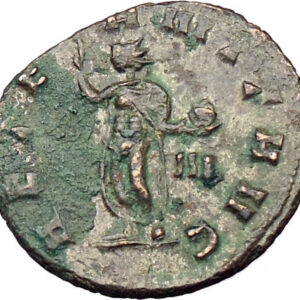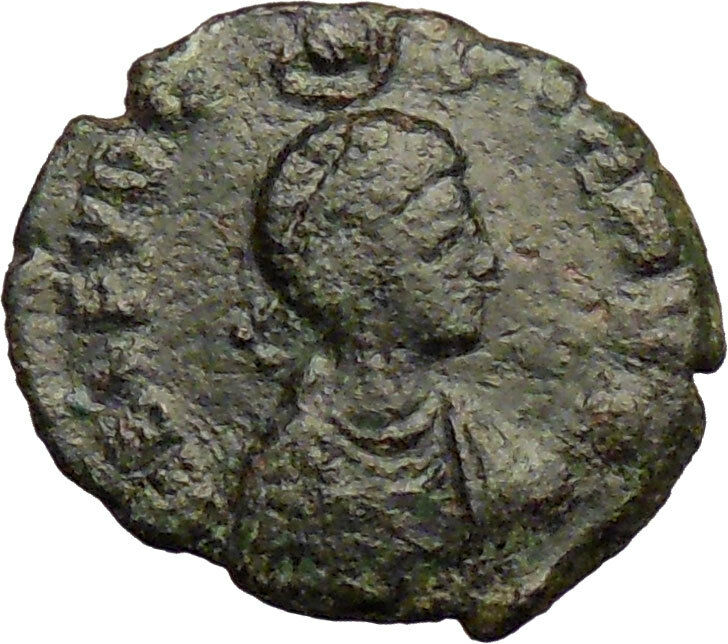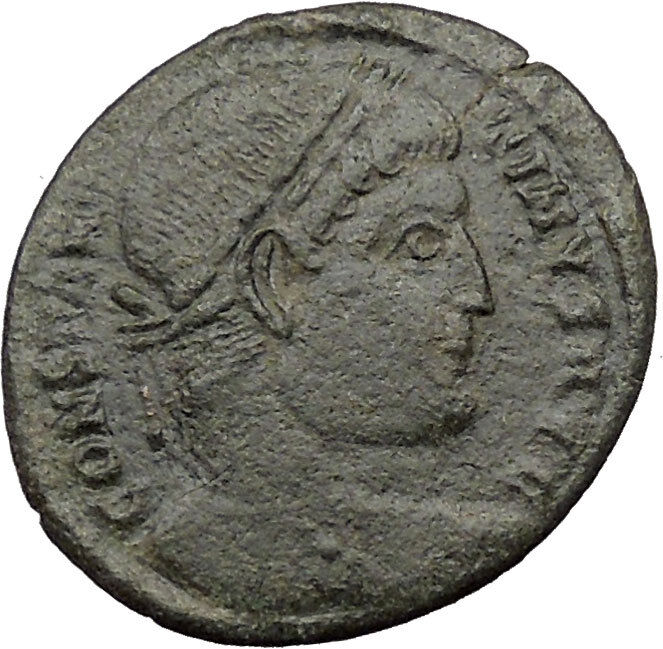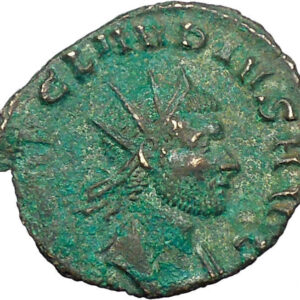|
Theodosius I ‘the Great’ –
Roman Emperor: 379-395 A.D.
Bronze AE4 12mm Antioch
mint, struck circa 383-392 A.D.
Reference: RIC IX 67b & 70a
Certification:
NGC Ancients Ch VF 5873009-015
DN THEODO-SIVS PF AVG, pearl
diademed, draped, cuirassed bust right.
SALVS REIPVBLICAE / (Staurogram)/ANTΔ,
Victory walking left, trophy on shoulder, dragging captive behind her.
You are bidding on the exact item
pictured, provided with a Certificate of Authenticity and Lifetime
Guarantee of Authenticity.
Staurogram _I_193_2.jpg/20px-Christliche_Symbolik_(Menzel)_I_193_2.jpg)
The Staurogram (meaning monogram of the cross, from the Greek
σταυρός, i.e. cross), or Monogrammatic Cross or Tau-Rho
symbol, is composed by a tau (Τ) superimposed on a rho (Ρ).
The Staurogram was first used to abbreviate the Greek word for cross in
very early New Testament manuscripts such as P66, P45 and P75, almost
like a nomen sacrum, and may visually have represented Jesus on the
cross.
Ephrem the Syrian in the 4th-century explained these two
united letters stating that the tau refers to the cross, and the rho
refers to the Greek word “help” which has the numerological value in
Greek of 100 as the letter rho has. In such a way the symbol expresses
the idea that the Cross saves. The two letters tau and rho can also be
found separately as symbols on early Christian ossuaries.
The tau
was considered a symbol of salvation due to the identification of the
tau with the sign which in Ezekiel 9:4 was marked on the forehead of the
saved ones, or due to the tau-shaped outstretched hands of Moses in
Exodus 17:11. The rho by itself can refer to Christ as Messiah because
Abraham, taken as symbol of the Messiah, generated Isaac according to a
promise made by God when he was one hundred years old, and 100 is the
value of rho.:158
The Monogrammatic Cross was later
seen also as a variation of the Chi Rho symbol, and it spread over
Western Europe in the 5th and 6th centuries.
Theodosius I ‘the Great’ –
Roman Emperor: 379-395 A.D.
379-383 A.D. Sole
Reign
383-395 A.D. Senior Augustus with
Arcadius
Ruling in the West:
Gratian (367-383 A.D.),
Valentinian II (375-392 A.D.),
Magnus Maximus (383-388 A.D.),
Flavius Victor (387-388 A.D.),
Eugenius (392-394 A.D.) and
Honorius (393-423 A.D.)
| Son-in-law of
Valentinian I | Brother-in-law of
Valentinian II | Husband of
Aelia Flacilla and Galla (sister of Valentinian II) | Father of
Arcadius and Honorius (by Aelia Flacilla), and of
Galla Placidia (by Galla) | Father-in-law of
Constantius III and
Aelia Eudoxia | Grandfather of Honoria,
Valentinian III,
Aelia Pulcheria and
Theodosius II | Great-grandfather of Licinia Eudoxia |
 Flavius Flavius
Theodosius ( 11 January 347 – 17 January 395), also called
Theodosius I and Theodosius the Great (Greek: Θεοδόσιος Α΄
and Θεοδόσιος ο Μέγας), was Roman Emperor from 379 to 395.
Reuniting the eastern and western portions of the empire, Theodosius was
the last emperor of both the Eastern and Western Roman Empire. After his
death, the two parts split permanently. He is also known for making
Nicene Christianity the official state religion of the Roman Empire.
Career
Theodosius was born in Cauca, in Hispania
(modern day Coca, Spain) or, more probably, in or near Italica
(Seville), to a senior military officer, Theodosius the Elder. He
accompanied his father to Britannia to help quell the Great Conspiracy
in 368. He was military commander (dux) of Moesia, a Roman
province on the lower Danube, in 374. However, shortly thereafter, and
at about the same time as the sudden disgrace and execution of his
father, Theodosius retired to Spain. The reason for his retirement, and
the relationship (if any) between it and his father’s death is unclear.
It is possible that he was dismissed from his command by the emperor
Valentinian I after the loss of two of Theodosius’ legions to the
Sarmatians in late 374.
The death of Valentinian I
in 375 created political pandemonium. Fearing further persecution on
account of his family ties, Theodosius abruptly retired to his family
estates where he adapted to the life of a provincial aristocrat.
From 364 to 375, the Roman Empire was governed by two co-emperors, the
brothers Valentinian I and Valens; when Valentinian died in 375, his
sons, Valentinian II and Gratian, succeeded him as rulers of the Western
Roman Empire. In 378, after Valens was killed in the Battle of
Adrianople, Gratian appointed Theodosius to replace the fallen emperor
as co-augustus for the East. Gratian was killed in a rebellion in
383, then Theodosius appointed his elder son, Arcadius, his co-ruler for
the East. After the death in 392 of Valentinian II, whom Theodosius had
supported against a variety of usurpations, Theodosius ruled as sole
emperor, appointing his younger son Honorius Augustus as his co-ruler
for the West (Milan, on 23 January 393) and defeating the usurper
Eugenius on 6 September 394, at the Battle of the Frigidus (Vipava
river, modern Slovenia) he restored peace.
Family
By his first wife, the probably Spanish
Aelia Flaccilla Augusta, he had two sons, Arcadius and Honorius and a
daughter, Aelia Pulcheria; Arcadius was his heir in the East and
Honorius in the West. Both Aelia Flaccilla and Pulcheria died in 385.
His second wife (but never declared Augusta) was Galla, daughter
of the emperor Valentinian I and his second wife Justina. Theodosius and
Galla had a son Gratian, born in 388 who died young and a daughter Aelia
Galla Placidia (392-450). Placidia was the only child who survived to
adulthood and later became an Empress; a third child, John, died with
his mother in childbirth in 394.
Diplomatic
policy with the Goths
The Goths and their allies
(Vandali, Taifalae, Bastarnae and the native Carpi) entrenched in the
provinces of Dacia and eastern Pannonia Inferior consumed Theodosious’
attention. The Gothic crisis was so dire that his co-Emperor Gratian
relinquished control of the Illyrian provinces and retired to Trier in
Gaul to let Theodosius operate without hindrance. A major weakness in
the Roman position after the defeat at Adrianople was the recruiting of
barbarians to fight against other barbarians. In order to reconstruct
the Roman Army of the West, Theodosius needed to find able bodied
soldiers and so he turned to the most capable men readily to hand: the
barbarians recently settled in the Empire. This caused many difficulties
in the battle against barbarians since the newly recruited fighters had
little or no loyalty to Theodosius.
Theodosius was
reduced to the costly expedient of shipping his recruits to Egypt and
replacing them with more seasoned Romans, but there were still switches
of allegiance that resulted in military setbacks. Gratian sent generals
to clear the dioceses of Illyria (Pannonia and Dalmatia) of Goths, and
Theodosius was able finally to enter Constantinople on 24 November 380,
after two seasons in the field. The final treaties with the remaining
Gothic forces, signed 3 October 382, permitted large contingents of
primarily Thervingian Goths to settle along the southern Danube frontier
in the province of Thrace and largely govern themselves.
The Goths now settled within the Empire had, as a result of the
treaties, military obligations to fight for the Romans as a national
contingent, as opposed to being fully integrated into the Roman forces.
However, many Goths would serve in Roman legions and others, as
foederati, for a single campaign, while bands of Goths switching
loyalties became a destabilizing factor in the internal struggles for
control of the Empire.
In 390 the population of
Thessalonica rioted in complaint against the presence of the local
Gothic garrison. The garrison commander was killed in the violence, so
Theodosius ordered the Goths to kill all the spectators in the circus as
retaliation; Theodoret, a contemporary witness to these events, reports:
the anger of the Emperor rose to the highest pitch, and he gratified
his vindictive desire for vengeance by unsheathing the sword most
unjustly and tyrannically against all, slaying the innocent and
guilty alike. It is said seven thousand perished without any forms
of law, and without even having judicial sentence passed upon them;
but that, like ears of wheat in the time of harvest, they were alike
cut down.
In the last years of
Theodosius’ reign, one of the emerging leaders of the Goths, named
Alaric, participated in Theodosius’ campaign against Eugenius in 394,
only to resume his rebellious behavior against Theodosius’ son and
eastern successor, Arcadius, shortly after Theodosius’ death.
Civil wars in the Empire

The administrative divisions of the Roman Empire in 395, under
Theodosius I.
After the death of Gratian in 383,
Theodosius’ interests turned to the Western Roman Empire, for the
usurper Magnus Maximus had taken all the provinces of the West except
for Italy. This self-proclaimed threat was hostile to Theodosius’
interests, since the reigning emperor Valentinian II, Maximus’ enemy,
was his ally. Theodosius, however, was unable to do much about Maximus
due to his still inadequate military capability and he was forced to
keep his attention on local matters. However when Maximus began an
invasion of Italy in 387, Theodosius was forced to take action. The
armies of Theodosius and Maximus met in 388 at Poetovio and Maximus was
defeated. On 28 August 388 Maximus was executed.
Trouble arose again, after Valentinian was found hanging in his room. It
was claimed to be a suicide by the magister militum, Arbogast.
Arbogast, unable to assume the role of emperor, elected Eugenius, a
former teacher of rhetoric. Eugenius started a program of restoration of
the Pagan faith, and sought, in vain, Theodosius’ recognition. In
January 393, Theodosius gave his son Honorius the full rank of Augustus
in the West, citing Eugenius’ illegitimacy.
Theodosius campaigned against Eugenius. The two armies faced at the
Battle of Frigidus in September 394. The battle began on 5 September 394
with Theodosius’ full frontal assault on Eugenius’ forces. Theodosius
was repulsed and Eugenius thought the battle to be all but over. In
Theodosius’ camp the loss of the day decreased morale. It is said that
Theodosius was visited by two “heavenly riders all in white” who gave
him courage. The next day, the battle began again and Theodosius’ forces
were aided by a natural phenomenon known as the Bora, which produces
cyclonic winds. The Bora blew directly against the forces of Eugenius
and disrupted the line.
Eugenius’ camp was stormed
and Eugenius was captured and soon after executed. Thus Theodosius
became the only emperor.
Art patronage
Theodosius oversaw the removal in 390 of an Egyptian obelisk from
Alexandria to Constantinople. It is now known as the obelisk of
Theodosius and still stands in the Hippodrome, the long racetrack that
was the center of Constantinople’s public life and scene of political
turmoil. Re-erecting the monolith was a challenge for the technology
that had been honed in the construction of siege engines. The obelisk,
still recognizably a solar symbol, had been moved from Karnak to
Alexandria with what is now the Lateran obelisk by Constantius II). The
Lateran obelisk was shipped to Rome soon afterwards, but the other one
then spent a generation lying at the docks due to the difficulty
involved in attempting to ship it to Constantinople. Eventually, the
obelisk was cracked in transit. The white marble base is entirely
covered with bas-reliefs documenting the Imperial household and the
engineering feat of removing it to Constantinople. Theodosius and the
imperial family are separated from the nobles among the spectators in
the Imperial box with a cover over them as a mark of their status. The
naturalism of traditional Roman art in such scenes gave way in these
reliefs to conceptual art: the idea of order, decorum and
respective ranking, expressed in serried ranks of faces. This is seen as
evidence of formal themes beginning to oust the transitory details of
mundane life, celebrated in Pagan portraiture. Christianity had only
just been adopted as the new state religion.
The
Forum Tauri in Constantinople was renamed and redecorated as the Forum
of Theodosius, including a column and a triumphal arch in his honour.
Nicene Christianity becomes the state religion
Theodosius promoted Nicene Trinitarianism within Christianity and
Christianity within the Empire. On 27 February 380, he declared
“Catholic Christianity” the only legitimate imperial religion, ending
state support for the traditional Roman religion.
Nicene Creed
In the 4th century, the Christian
Church was wracked with controversy over the divinity of Jesus Christ,
his relationship to God the Father, and the nature of the Trinity. In
325, Constantine I convened the Council of Nicea, which asserted that
Jesus, the Son, was equal to the Father, one with the Father, and of the
same substance (homoousios in Greek). The council condemned the
teachings of the theologian Arius: that the Son was a created being and
inferior to God the Father, and that the Father and Son were of a
similar substance (homoiousios in Greek) but not identical (see
Nontrinitarian). Despite the council’s ruling, controversy continued. By
the time of Theodosius’ accession, there were still several different
church factions that promoted alternative Christology.
Arians
While no mainstream churchmen within the
Empire explicitly adhered to Arius (a presbyter from Alexandria, Egypt)
or his teachings, there were those who still used the homoiousios
formula, as well as those who attempted to bypass the debate by merely
saying that Jesus was like (homoios in Greek) God the Father,
without speaking of substance (ousia). All these non-Nicenes were
frequently labeled as Arians (i.e., followers of Arius) by their
opponents, though they would not have identified themselves as such.
The Emperor Valens had favored the group who used the homoios
formula; this theology was prominent in much of the East and had under
the sons of Constantine the Great gained a foothold in the West.
Theodosius, on the other hand, cleaved closely to the Nicene Creed which
was the interpretation that predominated in the West and was held by the
important Alexandrian church.
Establishment of
Nicene Orthodoxy
On 26 November 380, two days
after he had arrived in Constantinople, Theodosius expelled the
non-Nicene bishop, Demophilus of Constantinople, and appointed Meletius
patriarch of Antioch, and Gregory of Nazianzus, one of the Cappadocian
Fathers from Antioch (today in Turkey), patriarch of Constantinople.
Theodosius had just been baptized, by bishop Acholius of Thessalonica,
during a severe illness, as was common in the early Christian world.
On 27 February 380 he, Gratian and Valentinian II published an edict in
order that all their subjects should profess the faith of the bishops of
Rome and Alexandria (i.e., the Nicene faith). The move was mainly a
thrust at the various beliefs that had arisen out of Arianism, but
smaller dissident sects, such as the Macedonians, were also prohibited.
The exact text of this decree, gathered in the Codex Theodosianus
XVI.1.2, was:
It is our desire that
all the various nations which are subject to our Clemency and
Moderation, should continue to profess that religion which was
delivered to the Romans by the divine Apostle Peter, as it has been
preserved by faithful tradition, and which is now professed by the
Pontiff Damasus and by Peter, Bishop of Alexandria, a man of
apostolic holiness. According to the apostolic teaching and the
doctrine of the Gospel, let us believe in the one deity of the
Father, the Son and the Holy Spirit, in equal majesty and in a holy
Trinity. We authorize the followers of this law to assume the
title of Catholic Christians; but as for the others, since, in
our judgment they are foolish madmen, we decree that they shall be
branded with the ignominious name of heretics, and shall not presume
to give to their conventicles the name of churches. They will suffer
in the first place the chastisement of the divine condemnation and
in the second the punishment of our authority which in accordance
with the will of Heaven we shall decide to inflict. (Henry
Bettenson, Documents of the Christian Church, Oxford
University Press, 1967, 2nd. (1st. 1943), p. 22).
In May 381, Theodosius summoned a new ecumenical council at
Constantinople (see First Council of Constantinople) to repair the
schism between East and West on the basis of Nicean orthodoxy. “The
council went on to define orthodoxy, including the mysterious Third
Person of the Trinity, the Holy Ghost who, though equal to the Father,
‘proceeded’ from Him, whereas the Son was ‘begotten’ of Him.” The
council also “condemned the Apollonian and Macedonian heresies,
clarified church jurisdictions according to the civil boundaries of
dioceses and ruled that Constantinople was second in precedence to
Rome.”
With the death of Valens, the Arians’
protector, his defeat probably damaged the standing of the Homoian
faction.
Conflicts with Pagans during the reign
of Theodosius I
Death of Western Roman Emperor
Valentinian II
On 15 May 392, Valentinian II was
found hanged in his residence in the town of Vienne in Gaul. The
Frankish soldier and Pagan Arbogast, Valentinian’s protector and
magister militum, maintained that it was suicide. Arbogast and
Valentinian had frequently disputed rulership over the Western Roman
Empire, and Valentinian was also noted to have complained of Arbogast’s
control over him to Theodosius. Thus when word of his death reached
Constantinople Theodosius believed, or at least suspected, that Arbogast
was lying and that he had engineered Valentinian’s demise. These
suspicions were further fueled by Arbogast’s elevation of a Eugenius,
pagan official to the position of Western Emperor, and the veiled
accusations which Ambrose, the Bishop of Milan, spoke during his funeral
oration for Valentinian.
Valentinian II’s death
sparked a civil war between Eugenius and Theodosius over the rulership
of the west in the Battle of the Frigidus. The resultant eastern victory
there led to the final brief unification of the Roman Empire under
Theodosius, and the ultimate irreparable division of the empire after
his death.
Proscription of Paganism
For the first part of his rule, Theodosius seems to have ignored the
semi-official standing of the Christian bishops; in fact he had voiced
his support for the preservation of temples or pagan statues as useful
public buildings. In his early reign, Theodosius was fairly tolerant of
the pagans, for he needed the support of the influential pagan ruling
class. However he would in time stamp out the last vestiges of paganism
with great severity. His first attempt to inhibit paganism was in 381
when he reiterated Constantine’s ban on sacrifice. In 384 he prohibited
haruspicy on pain of death, and unlike earlier anti-pagan prohibitions,
he made non-enforcement of the law, by Magistrates, into a crime itself.
In 388 he sent a prefect to Syria, Egypt, and Asia Minor with the aim of
breaking up pagan associations and the destruction of their temples. The
Serapeum at Alexandria was destroyed during this campaign. In a series
of decrees called the “Theodosian decrees” he progressively declared
that those Pagan feasts that had not yet been rendered Christian ones
were now to be workdays (in 389). In 391, he reiterated the ban of blood
sacrifice and decreed “no one is to go to the sanctuaries, walk through
the temples, or raise his eyes to statues created by the labor of man”.
The temples that were thus closed could be declared “abandoned”, as
Bishop Theophilus of Alexandria immediately noted in applying for
permission to demolish a site and cover it with a Christian church, an
act that must have received general sanction, for mithraea
forming crypts of churches, and temples forming the foundations of 5th
century churches appear throughout the former Roman Empire. Theodosius
participated in actions by Christians against major Pagan sites: the
destruction of the gigantic Serapeum of Alexandria by soldiers and local
Christian citizens in 392, according to the Christian sources authorized
by Theodosius (extirpium malum), needs to be seen against a
complicated background of less spectacular violence in the city:
Eusebius mentions street-fighting in Alexandria between Christians and
non-Christians as early as 249, and non-Christians had participated in
the struggles for and against Athanasius in 341 and 356. “In 363 they
killed Bishop George for repeated acts of pointed outrage, insult, and
pillage of the most sacred treasures of the city.”

Saint Ambrose and Emperor Theodosius, Anthony van Dyck.
By decree in 391, Theodosius ended the subsidies that had still trickled
to some remnants of Greco-Roman civic Paganism too. The eternal fire in
the Temple of Vesta in the Roman Forum was extinguished, and the Vestal
Virgins were disbanded. Taking the auspices and practicing witchcraft
were to be punished. Pagan members of the Senate in Rome appealed to him
to restore the Altar of Victory in the Senate House; he refused. After
the last Olympic Games in 393, it is believed that Theodosius cancelled
the games although there is no proof of that in the official records of
the Roman Empire, and the reckoning of dates by Olympiads soon came to
an end. Now Theodosius portrayed himself on his coins holding the
labarum.
The apparent change of policy that
resulted in the “Theodosian decrees” has often been credited to the
increased influence of Ambrose, bishop of Milan. It is worth noting that
in 390 Ambrose had excommunicated Theodosius, who had recently given
orders which resulted in the massacre of 7,000 inhabitants of
Thessalonica, in response to the assassination of his military governor
stationed in the city, and that Theodosius performed several months of
public penance. The specifics of the decrees were superficially limited
in scope, specific measures in response to various petitions from
Christians throughout his administration.
Some
modern historians question the consequences of the laws against pagans.
Death
Theodosius died, after battling the
vascular disease oedema, in Milan on 17 January 395. Ambrose organized
and managed Theodosius’s lying in state in Milan. Ambrose delivered a
panegyric titled De Obitu Theodosii before Stilicho and Honorius
in which Ambrose detailed the suppression of heresy and paganism by
Theodosius. Theodosius was finally laid to rest in Constantinople on 8
November 395.
|









_I_193_2.jpg/20px-Christliche_Symbolik_(Menzel)_I_193_2.jpg)
 Flavius
Flavius 






